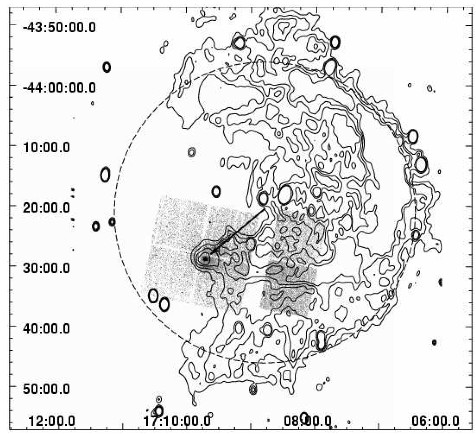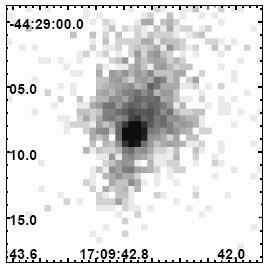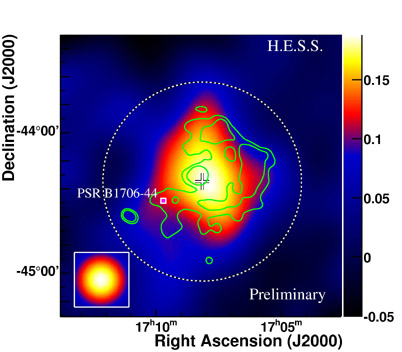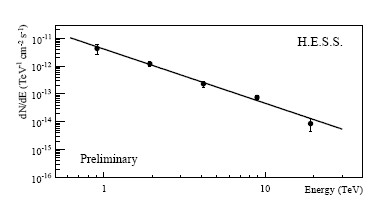An Extended Source of Gamma Rays near PSR B1706-44
August 2009

The pulsar PSR B1706-44 (see ATNF pulsar catalog) is in a number of respects an enigmatic object. With a spin period of 102 ms, an age of about 17,500 years, a rather high spin-down luminosity, and a distance estimated in the 2-3 kpc range, it belongs to the class of relatively young and powerful pulsars which are prime candidates as very-high-energy (VHE) gamma-ray sources. Indeed, the pulsar is surrounded by a 2-3 arcminute nebula of sychrotron emission from high-energy electrons, detectable in the radio (Giacani et al. 2001) as well as in X-rays (Gotthelf et al. 2002). Detailed studies with Chandra revealed evidence for a termination shock of an equatorial pulsar wind and for polar jets, embedded in the pulsar wind nebula (Fig. 1, Romani et al. 2005). EGRET detected strong pulsed emission at GeV energies (Thompson et al. 1996).
The region of PSR B1706-44 was detected as a source of TeV gamma rays with the CANGAROO 3.8 m telescope (Kifune et al. 1995); the detection of an unpulsed flux of VHE gamma rays was confirmed a few years later by the Durham Mark 6 telescope (Chadwick et al. 1998). First observations of the region with the H.E.S.S. telescopes during the commissioning phase in 2003, however, failed to reveal a VHE gamma-ray source, and flux limits obtained were an order of magnitude below the reported flux (Aharonian el al. 2005). The story continues in 2009, when a reanalysis of the old CANGAROO 3.8 m data revealed problems with the earlier processing of the data and failed to reproduce the signal (Yoshikoshi et al. 2009). At the International Cosmic Ray Conference 2009 in Lodz, both H.E.S.S. (Hoppe et al. 2009), see Fig. 2 and Fig. 3, and the CANGAROO III telescope system (Enomoto et al. 2009) reported detection of extended VHE gamma-ray emission from the region near the pulsar. However, once more the results are not fully consistent. The source as reconstructed based on H.E.S.S. observations has a (Gaussian) width of 0.3 degrees and a flux of about 17% of the Crab flux, whereas Enomoto et al. find a considerably larger and stronger source, more of less filling the entire field of view; the difference may be related to the way the background under the signal is estimated and subtracted.
Given the extended nature of the source, it is unclear if the emission is to be associated with the pulsar PSR B1706-44 - located at the edge of the H.E.S.S. source - or with the supernova remnant G343.1-2.3, in which the pulsar is thought to be embedded. Based on energetics and information in other wavebands, neither interpretation can be excluded (Hoppe et al. 2009). Furthermore, it is not even clear if the pulsar and the remnant are associated in that both result from the same supernova explosion. The off-center position of the pulsar relative to the radio arc of the remnant implies a very high proper motion of the pulsar (the arrow in the top image), incompatible with other estimates of the pulsar's motion (Nicastro 1996); on the other hand, Bock and Gavamadze (2002) argued that the visible radio shell might be deformed by interaction with a molecular cloud. Clearly, only better data in all wavebands can help to address the many open questions surrounding PSR B1706-44 / G343.1-2.3.
Reference: S. Hoppe et al., "Detection of very-high-energy gamma-ray emission from the vicinity of PSR B1706-44 with H.E.S.S", Proceedings of the 31st International Cosmic Ray Conference, Lodz, 2009, and arXiv:0906.5574.


